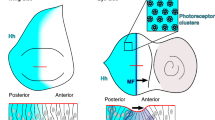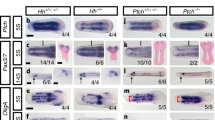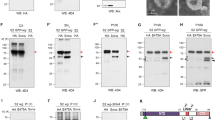Abstract
MEMBERS of the Hedgehog family of secreted proteins control a number of important inductive interactions in the development of both vertebrates and Drosophila1, but little is known about the ways in which their signalling activities are transduced. In Drosophila, hedgehog is one of the segment-polarity genes, mutations of which disrupt the pattern and polarity of individual embryonic segments2 and their adult derivatives3; several of these genes have been implicated in transduction of the hedgehog signal4–6. Here we show that the segment-polarity gene smoothened is required for the response of cells to hedgehog signalling during the development of both the embryonic segments and imaginal discs. Sequence analysis of the smoothened transcription unit reveals a single open reading frame encoding a protein with seven putative transmembrane domains. This structure is typical of G-protein-coupled receptors, suggesting that the Smoothened protein may act as a receptor for the Hedgehog ligand.
This is a preview of subscription content, access via your institution
Access options
Subscribe to this journal
Receive 51 print issues and online access
$199.00 per year
only $3.90 per issue
Buy this article
- Purchase on Springer Link
- Instant access to full article PDF
Prices may be subject to local taxes which are calculated during checkout
Similar content being viewed by others
References
Ingham, P. W. Opin. Gen. Dev. 5, 492–498 (1995).
Nüsslein-Volhard, C. & Wieschaus, E. Nature 287, 795–801 (1980).
Williams, J. A. & Carroll, S. B. Bioessays 15, 567–577 (1993).
Ingham, P. W., Taylor, A. M. & Nakano, Y. Nature 353, 184–187 (1991).
Ingham, P. W. Nature 366, 560–562 (1993).
Forbes, A. J., Nakano, Y., Taylor, A. M. & Ingham, P. W. Development (suppl.), 115–124 (1993).
Klingensmith, J. & Nusse, R. Dev. Biol. 166, 396–414 (1994).
Ingham, P. W. & Martinez-Arias, A. Cell 68, 221–235 (1992).
Nüsslein-Volhard, C., Wieschaus, E. & Kluding, H. Roux's Arch. Dev. Biol. 193, 267–282 (1984).
Bejsovec, A. & Martinez-Arias, A. Development 113, 471–485 (1991).
Ingham, P. W. & Hidalgo, A. Development 117, 283–291 (1993).
van den Heuvel, M., Harryman-Samos, C., Klingensmith, J., Perrimon, N. & Nusse, R. EMBO J. 12, 5293–5302 (1993).
Hooper, J. E. Nature 372, 461–464 (1994).
Blair, S. S. BioEssays 17, 299–309 (1995).
Raftery, L. A., Sanicola, M., Blackman, R. K. & Gelbart, W. M. Development 113, 27–33 (1991).
Xu, T. & Rubin, G. M. Development 117, 1223–1237 (1993).
Kalderon, D. Curr. Biol. 5, 580–582 (1995).
Smoller, D. A., Pertov, D. & Harti, D. L. Chromosoma 100, 487–494 (1991).
Wang, Y. et al. J. biol. Chem. 271, 4468–4476 (1996).
Dohlman, H. G., Thorner, J., Caron, M. G. & Lefkowitz, R. J. Annu. Rev. Biochem. 60, 653–688 (1991).
Daub, H., Weiss, F. U., Wallasch, C. & Ullrich, A. Nature 379, 557–560 (1996).
Grand, R. J. A., Turnell, A. S. & Grabham, P. W. Biochem. J. 313, 353–368 (1996).
Nakano, Y. et al. Nature 341, 508–513 (1989).
Hooper, J. & Scott, M. P. Cell 59, 751–765 (1989).
Clapham, D. E. & Neer, E. J. Nature 365, 403–406 (1993).
Mohler, J. Genetics 120, 1061–1072 (1988).
Chou, T. B. & Perrimon, N. Genetics 131, 643–653 (1992).
Brand, A. & Perrimon, N. Development 118, 401–415 (1993).
Capdevilla, J. & Guerrero, I. EMBO J. 13, 4459–4468 (1994).
Panganiban, G. E., Reuter, R., Scott, M. P. & Hoffman, F. M. Mol. Cell. Biol. 10, 2669–2677 (1990).
Cavener, D. R. Nucleic Acids Res. 15, 1353–1361 (1987).
Brown, N. H. & Kafatos, F. C. J. Mol. Biol. 203, 425–437 (1988).
Author information
Authors and Affiliations
Rights and permissions
About this article
Cite this article
van den Heuvel, M., Ingham, P. smoothened encodes a receptor-like serpentine protein required for hedgehog signalling. Nature 382, 547–551 (1996). https://doi.org/10.1038/382547a0
Received:
Accepted:
Issue Date:
DOI: https://doi.org/10.1038/382547a0
This article is cited by
-
Sonic Hedgehog Signaling Pathway: A Role in Pain Processing
Neurochemical Research (2023)
-
Hedgehog signaling and its molecular perspective with cholesterol: a comprehensive review
Cellular and Molecular Life Sciences (2022)
-
Emerging roles of the Hedgehog signalling pathway in inflammatory bowel disease
Cell Death Discovery (2021)
-
The emerging roles of phosphatases in Hedgehog pathway
Cell Communication and Signaling (2017)
-
Capping Enzyme mRNA-cap/RNGTT Regulates Hedgehog Pathway Activity by Antagonizing Protein Kinase A
Scientific Reports (2017)
Comments
By submitting a comment you agree to abide by our Terms and Community Guidelines. If you find something abusive or that does not comply with our terms or guidelines please flag it as inappropriate.



